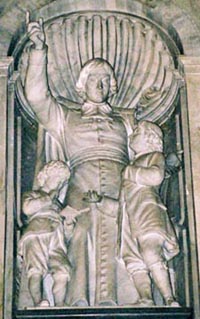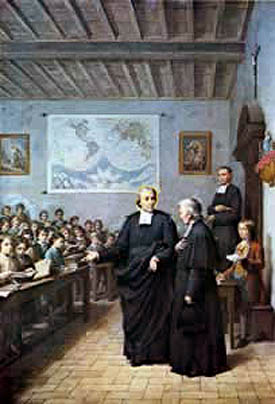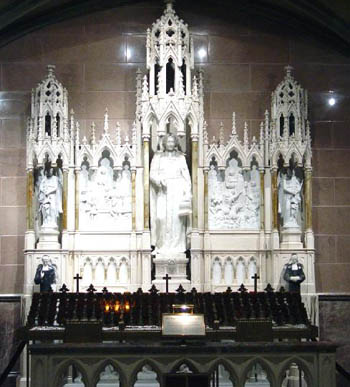 |
The Saint of the Day
St. John Baptist de la Salle – May 15
Prof. Plinio Corrêa de Oliveira
Biographical selection:
John Baptist was born in Rheims, France in 1651 into a family of magistrates. He was the eldest of ten children. While still a boy, he felt a profound nausea at a social gathering regarding everything that surrounded him. He spoke to a cousin, who recognized something special in the boy and began to read the lives of the saints to him.
At age eleven he received the tonsure, and in 1667 he was solemnly installed as a canon of the See of Rheims. In 1670 he was sent to Paris to study theology at the Seminary of Saint-Sulpice. While residing there he attended lectures in theology at the Sorbonne. There, he came under the spiritual direction of the well-known Msgr. Louis Tronson and made rapid progress in virtue
In July 1671 his mother died. A year later, his father also died. This obliged him to leave Paris and return home. At age 21 and as head of the family, he had the responsibility of educating his brothers and sisters.
At that time, a wealthy lady in Rouen had founded a free school for orphan boys. The model was brought to Rheims by a lay teacher, Arien Niguel, who was hosted by John Baptist de la Salle in his house. This contact opened his eyes to the need for the Catholic education of poor boys, and he undertook the task of preparing teachers for these schools. Later, St. John de la Salle wrote in a memoir:
"If I had ever thought that what I did out of pure charity for the poor school teachers would make it incumbent upon me to live with them, I would have given it up at once. I used to consider their condition lower than that of the servants, which would have made the idea of living with them something insupportable.”
This implicit admittance was, however, the beginning of the mission of St. John Baptist: the organization of free primary Catholic schools for poor boys, and the foundation of the Brothers of the Christian Schools, commonly called the Christian Brothers. By assuming this initiative, he indirectly put not only his relatives but almost all his city against him, since at the time the notion of providing education for the lower classes was novel and not accepted.

St. John Baptist teaching
|
When he wrote the rules for this Institute, he wanted its members to live without money, confiding in Divine Providence. His companions murmured, saying that this was very easy for him, a canon with a good income, but not for the others. He left his position and distributed his goods to the poor. Then his disciples complained that it was a crime to not distribute the goods among them instead of the poor.
Soon after the institute and the schools were organized, persecutions started against the lay teachers. Just seeing them in their habit was motive for their opponents to boo them in the streets and throw mud in their faces.
He defended frequent Communion for the lay teachers and boys, which raised the ire of the Jansenists and caused him to be abandoned by many of his disciples.
Fr. John Baptist’s later years were spent at the College of Saint Yon in Rouen, where the novitiate functioned. In 1716 he resigned from the active direction and government of the Institute. The priest in charge of the noviate took advantage of the situation to mistreat him.
Two days before he died, the Archbishop of Rouen, due to the frequent polemics St. John Baptist raised, deprived him of his priestly powers, as if he were an unworthy priest. The Saint smiled and said: “I hope to be liberated shortly from Egypt, and enter into the Promised Land of the elect.”
He achieved his aim on April 7, 1719, a Good Friday, at the age of 67.
Comments of Prof. Plinio:
This selection is very beautiful because it shows the sufferings that St. John Baptist de la Salle had to endure. However, on the other hand, it is one-sided, because it does not show how he accomplished his mission. It shows some of the turns the river made, but it does not show how the river reached the ocean.
Let me try to rectify this picture. In the time of St. John Baptist de la Salle, the ecclesiastical structure of France was disorganized as a consequence of the religious wars between the Protestants and Catholics. The good influence of the Counter-Reformation was also coming to an end. In the French clergy, customs had become very slack and apostolic zeal had waned. For these reasons the clergy was very interested in working with persons who could offer advantages, that is, with the nobles, magistrates and wealthy. It scorned the apostolate with poor and simple boys.

His mission was to provide
a Catholic education for poor boys
|
It was a completely wrong orientation, but it is understandable. Society still had a strong hierarchical structure, and the great advantages could only come from the top. So, the careless and slovenly clergy sought out the rich and scorned the poor. As a result, a great number of children grew up without any religious instruction. These new generations were thus destined to be completely pagan.
In a certain way this situation was the opposite of the one we have in our days, and in a certain way it was similar. It was similar because today we also have a careless and slovenly clergy who lack apostolic zeal. They also are sycophants of the famous of our day, eager to take advantage of them.
But it happens that the great ones of our day are no longer nobles, magistrates, or intellectuals. The ones with power are the leftists who are promoted by the demagogic media. These organs only advance those who are socialist and anti-hierarchical, those who are revolutionaries. So, the slovenly clergy seeks its advantages from political leaders, heads of workers’ movements, or the leaders of the so-called discriminated-against minorities. This is the difference, an almost completely opposite situation.
But at that time, when the Revolution still had not destroyed social hierarchy, the winds of the fashion dictated a scorn for the little people and the poor, and so the worldly clergy and society followed this current.
St. John Baptist de la Salle took a different course. He set aside his own social standing, his ecclesiastical privileges as a canon, and his promising career, and went to help those whom the Revolution scorned. He sought out the boys who had been abandoned, and formed an institute of lay brothers who specialized in teaching these children.
We have to imagine how the teaching of a saint like St. John Baptist de la Salle would have been – his seriousness in explaining the Catholic principles for the boys, the profound impression he made on their souls, the blessings that his words spread among them. Those classes would have been a true marvel of Catholic spirit, exerting an enormous influence over those boys who, in many ways, would constitute the future of France.
He did not limit himself to teaching, but also founded an institute of priests and laymen completely dedicated to teaching youth. Therefore, it did not remain the work of a single man, but shortly he had congregated hundreds of teachers with the same aim. It was a new kind of vocation in the Church – persons who leave the world with the sole aim of teaching boys to become good Catholics. This congregation spread everywhere, and became an important force in the Church and society.
Therefore, he was called to realize this mission, a very elevated work. He faced many obstacles along the way, but he ended by achieving his aim. This straight line, limpid and clear, represents the accomplishment of his vocation. He succeeded before God, but he also succeeded before men, because he left a great work behind him.

The altar of St. John Baptist de la Salle
at St. Patrick's Cathedral in New York |
Along the way, the course of the river made countless turns in face of the obstacles, which changed its direction before reaching the ocean. So, he had to face all the difficulties the selection mentions. He was rejected by his family, his closest friends and many of his disciples; he was mocked by the inhabitants of his city and persecuted by representatives of the very Church to which he had dedicated his life.
We see that Our Lady permitted him to suffer all those things in order to water, with the merit of his suffering and blood, the seed that he planted.
Accepting those sufferings, he became a model for the works of any apostolate. Every apostolate has to have suffering and relies on the blood of the souls of those who are called to make it. At times, it even calls for real blood, asking the apostle to shed it.
The most difficult obstacle to overcome was the appearance of absurdity of the work St. John Baptist de Salles was called to do. Very often a person called to do a great work has to face great waves of opposition that make his vocation appear senseless. This appearance of incoherence is one of the most painful dilacerations a person can suffer, because it seems to stand in the way of the mission to which the Holy Ghost had called him.
Even if we do not have the vocation of teaching children, we should admire the life of St. John Baptist de la Salle. It offers us the opportunity to contemplate the many different vocations the Holy Ghost placed in the Catholic Church and how rich she is. She is a treasure in which we can find all precious things, each one with its own beauty, value and splendor. We should glorify Our Lord Jesus Christ for that.
Let us pray to St. John Baptist de la Salle to help us increase our admiration for all the vocations encompassed by Holy Mother Church.


  | | Prof. Plinio Corrêa de Oliveira | |
The Saint of the Day features highlights from the lives of saints based on comments made by the late Prof. Plinio Corrêa de Oliveira. Following the example of St. John Bosco who used to make similar talks for the boys of his College, each evening it was Prof. Plinio’s custom to make a short commentary on the lives of the next day’s saint in a meeting for youth in order to encourage them in the practice of virtue and love for the Catholic Church. TIA thought that its readers could profit from these valuable commentaries.
The texts of both the biographical data and the comments come from personal notes taken by Atila S. Guimarães from 1964 to 1995. Given the fact that the source is a personal notebook, it is possible that at times the biographic notes transcribed here will not rigorously follow the original text read by Prof. Plinio. The commentaries have also been adapted and translated for TIA’s site.
|
Saint of the Day | Home | Books | CDs | Search | Contact Us | Donate

© 2002- Tradition in Action, Inc. All Rights Reserved
|
 |

|